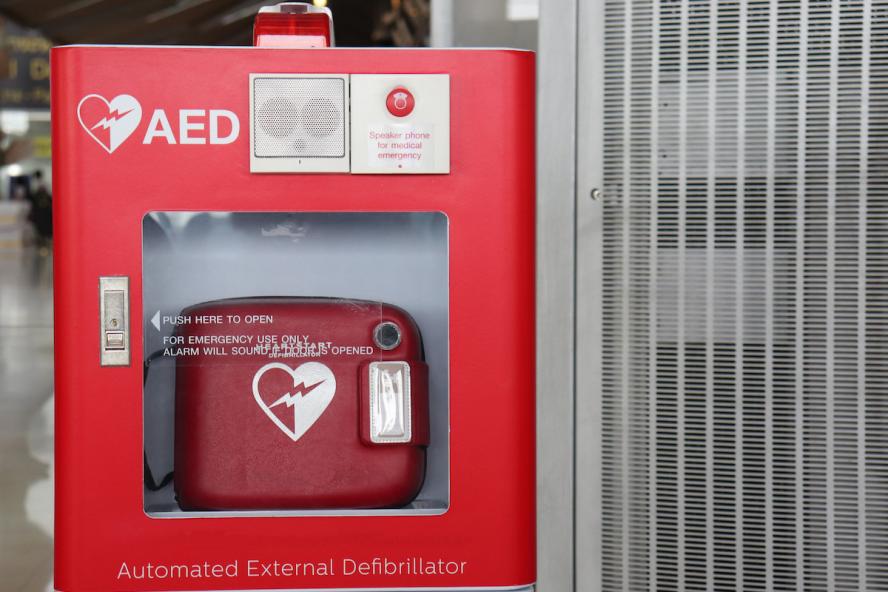-
About
- Leadership & Faculty
- News & Events
-
Academics
- Graduate
- Advanced Clinical Training
- Continuing Education
- Academic Departments
- Academic Offices
- Simulation Experiences
-
Student Life
- Offices
-
Research
-
Hospitals & Clinics
- Emergency Care
- Hospital Services
-
Community Outreach
- Volunteer
Can Human AEDs Work on Dogs?
Research published by Cummings School of Veterinary Medicine evaluates effectiveness of human automated external defibrillators on dogs

An article published by a group of researchers at Cummings School of Veterinary Medicine at Tufts University has concluded that human automated external defibrillators (AEDs) on dogs can successfully record electrical activity and detect and treat “shockable” rhythms.
Published in the March 2023 issue of the Journal of Veterinary Emergency and Critical Care, “Evaluation of automated external defibrillator designed for people in dogs,” was authored by five investigators, led by Dr. Elizabeth Rozanski, associate professor in Cummings School’s Department of Clinical Sciences and a member of the emergency and critical care team at Henry and Lois Foster Hospital for Small Animals.
Fellow authors of the article included Cummings School Drs. Emily Karlin, V08; Joey LaMastro, and John Rush, as well as graduate Meriel LeSueur, V22, who is completing a rotating internship at North Carolina State University and will be pursuing a residency in veterinary cardiology at the University of Florida.
“Through this study we determined that human AEDs can effectively save the life of a dog whose heart has stopped effectively pumping blood and requires defibrillation,” says Rozanski. “The AED device can also make recommendations for the delivery of shock. We also looked at the required preparation of a dog’s haircoat to obtain a readable electrocardiogram (ECG) where we found smooth coated dogs like Boxers require little to no preparation, while dogs with thicker coats like retrievers require some fur removal.”
The research studied 42 dogs treated at Foster Hospital in early 2021. The dogs were arranged in three groups: (1) healthy dogs with no known arrhythmia, (2) client-owned dogs with known arrhythmia, and (3) client-owned dogs experiencing naturally occurring cardiopulmonary arrest. The study found a readable ECG in all cases, while the clipping of heavy haircoats and the application of ECG paste on the AED pad was required in 83 percent of the clients to produce the most reliable ECG readings. One dog, who was in fibrillation, was successfully defibrillated and discharged home.
“These results concluded that an AED designed for humans can successfully interpret the cardiac rhythm in dogs, determine if a shockable rhythm is present, and provide appropriate shock advice for the vast majority of dogs,” says Rozanski.
With the widespread implementation of AEDs in public spaces to reduce the time between collapse and delivery of a shock, many human lives have been saved, “such as the life of Buffalo Bills’ player Damar Hamlin,” Rozanski notes. “In many cases, it’s the difference between life and death.”
Sudden ventricular fibrillation is a common cause of out of hospital death. According to the Red Cross, the average response time to a 9-1-1 call is 8–12 minutes, and the odds of survival are reduced by approximately 10% for each minute defibrillation is delayed after arrest. Using an AED in these cases can truly save lives.
“AEDs are easy to use, and they are not that expensive [ranging from $1,200 to $2,500 according to several online sources],” says Rozanski. “It is so important to have these available in public spaces to greatly increase the chance of saving lives. Ideally, I would love to see AED in all veterinary practices and all dog events, where if either a person or a dog suffered a collapse associated with ventricular fibrillation they could be promptly resuscitated.”
In the results of the study, the researchers recommended replication of the data on a larger scale, including evaluation of more dogs with a variety of arrhythmias to clarify AED function, as well as dogs experiencing CPA to evaluate AED shock success at restoring a normal rhythm.